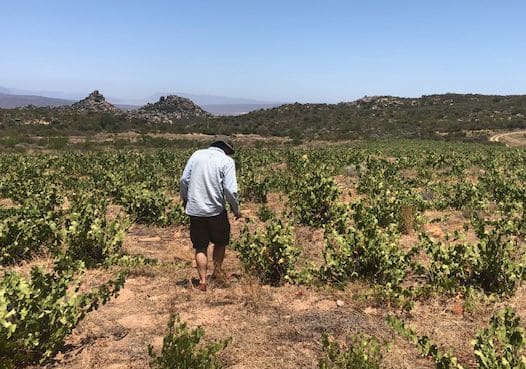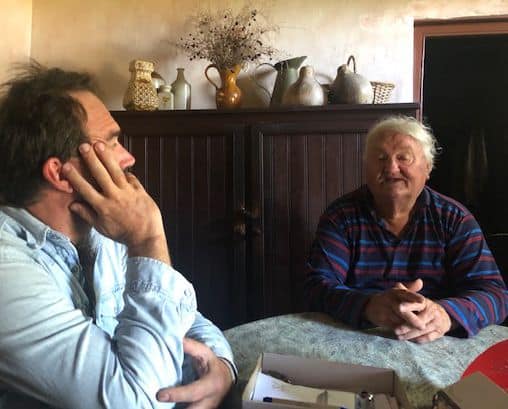Tim James: A fine new Pinotage from Piekenierskloof
By Tim James, 29 June 2020
I thought that Tierhoek’s were the most distantly remote vineyards in the lovely high Piekeniershoek plateau – mountains both near and far on all horizons, and little sign of human presence or labour apart from the vines themselves. But last summer, as the grapes were moving to maturity (and lockdown was a foreign idea), Rudiger Gretschel drove me on a dwindling road, well past Tierhoek, further, to where the road ended, and the pinotage vines that produce his new wine, Sangiro, were growing. You don’t get much further from neighbouring vineyards anywhere in the Cape. “Welkom op Swartberg”, says a modest sign painted on an old plough disc at the entrance.

Rudiger, production director for major wine company Vinimark (and particularly significantly involved in the wines of Reyneke and Krone), has been interestedly sniffing round Piekenierskloof for nearly two decades now, since he first went there to harvest grapes for Boekenhoutskloof Chocolate Block. He got to discover this “very special place” about ten years back. The rugged beauty of the location I could see for myself, but he listed some viticultural advantages of the situation for me: high altitude for coolness – though the 2.4 hectares of pinotage get full sun, with no mountain shading; it faces the ocean; there’s spring water available; and its sheer remoteness: it is free from electrical interference.
That last criterion hints at an element of something like mysticism that Rudiger invokes when talking about these vineyards (there’s a mixed plot of white grapes too from which a white wine might come), and Smuts’s concept of holism, where the parts conjoin to generate some whole greater than themselves, and where there’s a complex interaction of natural elements. For him, “this little plot of green” goes beyond mere agriculture; it has “been accepted into this environment” and has “become part of the whole ecosystem”. It is farmed, of course – though there are “no tractors, no seeding for winter cover crops (wild Namaqua flowers serve that purpose); a bit of spraying for mildew, but definitely no herbicides”. In fact, there is little disease pressure, because of the modest scale of the plantings.

Which brings us to the farmer – and his assistants, whose names I got only as Frikkie and Gert; on the day we visited (as on every day at this time of year, I believe), they were continuously patrolling the vines with long stock-whips, which occasionally cracked as the two men scared off another little flock of starlings intent on their own harvest of ripe grapes. The farm (about 1000 hectares in total, with just a little rooibos and citrus as well as the vines) belongs to Jurgens Hanekom, “Prof” to Rudiger, a former academic from Stellenbosch University, now 80 years old. He retired some 30 years back with a supposedly life-threatening disease, since when he’s been spending his weeks up here, living in peace and silence like a hermit in the little house on the farm, taking care of his plantings, and returning to town and his wife on the weekends. Clearly it’s a recipe for health – and seemingly for contentment too. Rudiger is a not infrequent visitor, and I could see that for him “the prof” is an integral part of the satisfying whole.
The three of us shared a simple, delicious lunch that Rudiger had brought, along with a bottle of 2017 Sangiro, the first vintage of his wine off the vineyards around us.
What of that wine? Which is vinified, incidentally, back in Stellenbosch – though the yeast that ferments it is only what was growing on the grapes; the wine matures for some eleven months in old oak barrels. The photogravure labels, hand torn, feature a rather blurry photograph of bare-legged, behatted Jurgens and Rudiger on the bench outside the little thick-walled, dim farmhouse. Rudiger writes the name and vintage on each label, and the number of the bottle: the one I have in front of me now is 127/1790.
I first tasted the wine nearly a year ago for Platter’s, with Cathy van Zyl – it’s listed under Swartberg Wingerde; the wine itself couldn’t be named for the farm because of the existing, far distant WO of that name and instead is called Sangiro, after the pseudonym of AA Pienaar, whose works, revealing a love and understanding of the wild, Rudiger admires). We both thought that Sangiro 2017 (at 13.2% alcohol) was successfully poised between the bright, red-fruited, perfumed, pure and fresh style of the new wave, and the richer weightiness (though not the oaky sweetness) of more traditional examples. Tasting it again now, that remains valid, but the lighter freshness is revealed as increasingly important, though the grippy tannins make it clear that this is a serious wine for ageing. There’s the slightest tinge of finishing bitterness, which doesn’t detract, but rather adds to the interest. It’s undoubtedly a fine, serious wine and I think it will usefully settle into a little more flesh and harmony, as well as complexity, with a few more years in bottle. It adds a useful dimension to the range of Cape pinotage.
Sangiro should be becoming available now, priced around R500 per bottle. Try imagining that lonely, distant vineyard when you drink its wine.
- Tim James is one of South Africa’s leading wine commentators, contributing to various local and international wine publications. He is a taster (and associate editor) for Platter’s. His book Wines of South Africa – Tradition and Revolution appeared in 2013
Attention: Articles like this take time and effort to create. We need your support to make our work possible. To make a financial contribution, click here. Invoice available upon request – contact info@winemag.co.za








Comments
0 comment(s)
Please read our Comments Policy here.